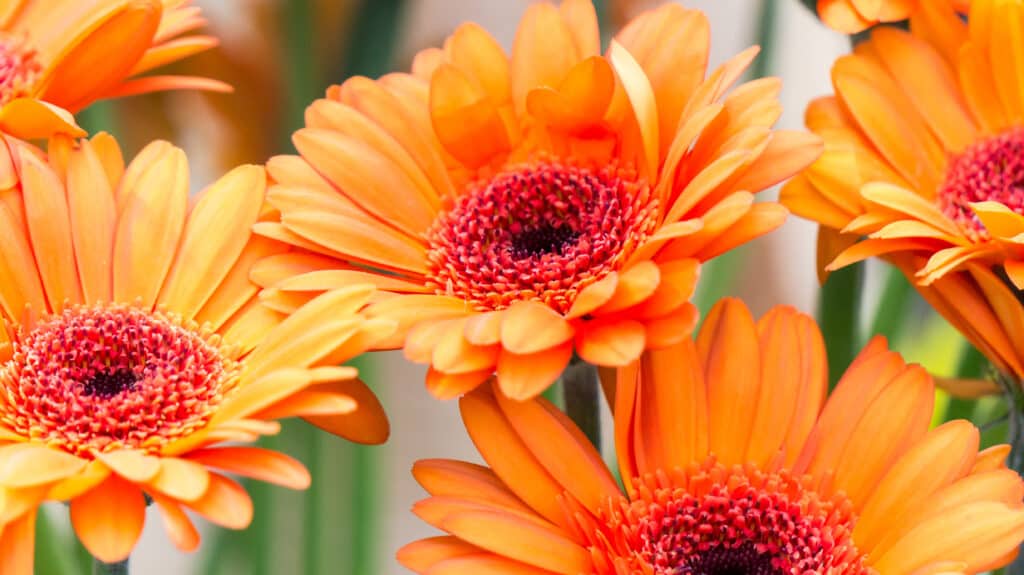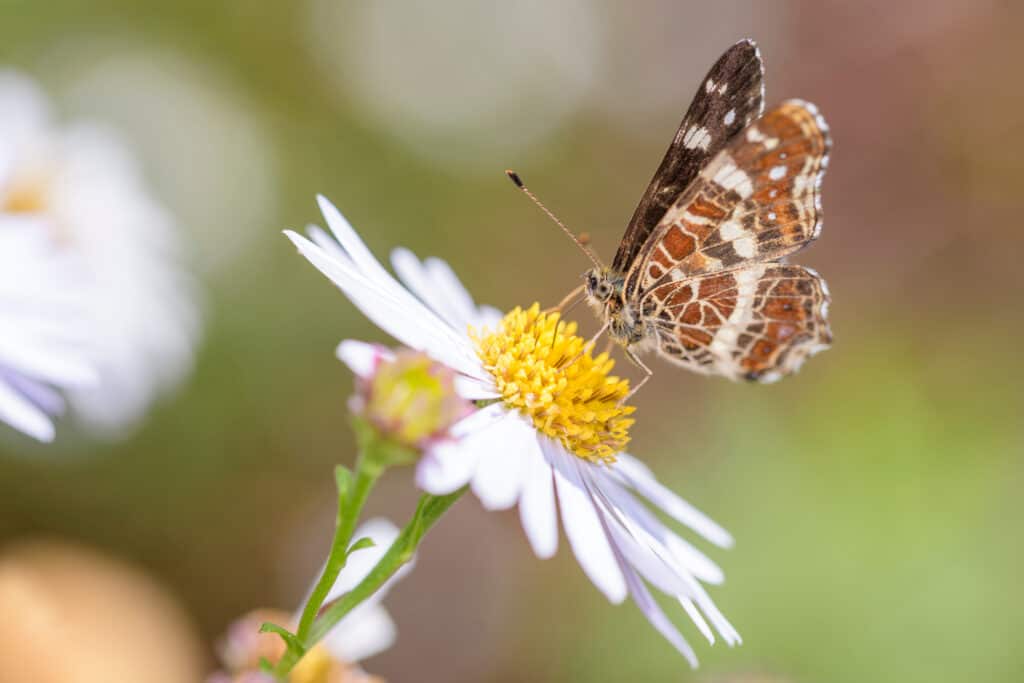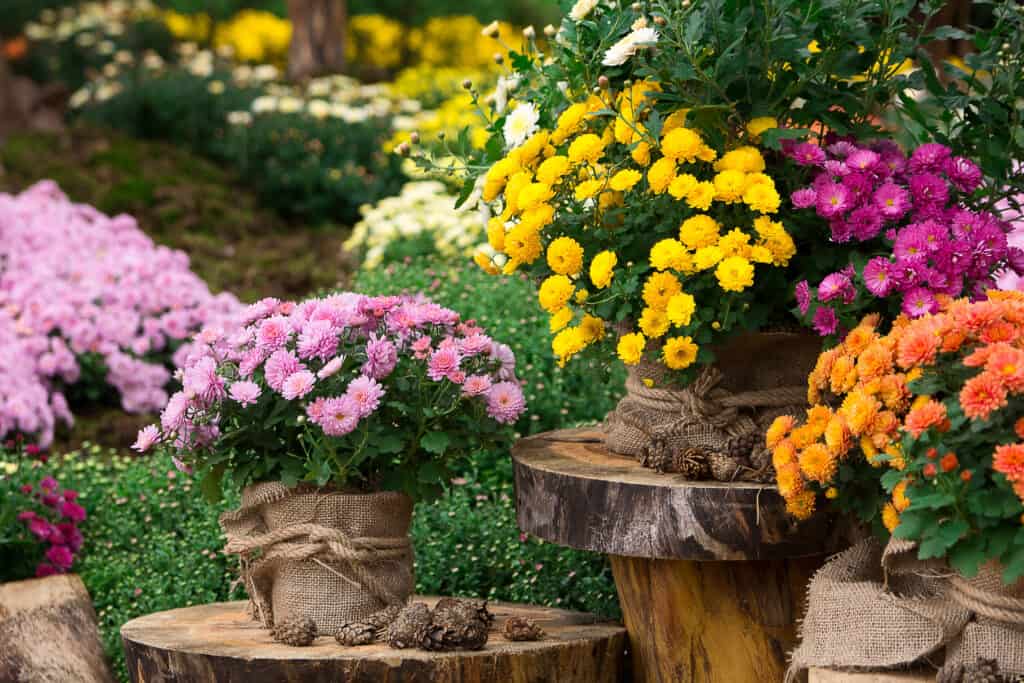Chrysanthemums and daisies are two flowers that are extremely popular with gardeners, florists, and recipients of cut flower arrangements. The gorgeous flowers can sometimes be mistaken for each other, depending on which kind of variety is included in their space, so often people aren’t sure what they’re looking at: chrysanthemum vs. daisy?
They both have numerous petals and easily work for that old game “he-loves-me-he-loves-me-not” but they’re not at all the same flowers.
Let’s take a look at the many unique qualities and differences found between the flowers, including their uses, genus, and origins.

Gerbera daisies come in a wide range of colors.
©Andrey Shepetov/Shutterstock.com
| Chrysanthemum | Daisy | |
|---|---|---|
| Classification | Chrysanthemum indicum; approximately 40 species, innumerable variations and cultivars | Bellis perennis; over 1,500 genera and 23,000 species |
| Description | Mums have alternating leaves with distinctive edges and may have a single or multi-head flower. They come in many colors including red, white, pink, purple, lavender, maroon, and bicolor. | Daisies come in many forms and colors, from white with yellow centers to bicolor with dark centers. You may find them in pink, red, white, orange, yellow, purple, and other shades, growing on a leafless stalk. |
| Uses | Chrysanthemums are beautiful flower for ornamental purposes in gardens and houseplants. They also are believed to have medicinal properties that may help to treat insulin resistance and heart conditions. | Daisies are often used for ornamental purposes, such as potted plants and cut flowers. For many years, they have also been used in herbal remedies and natural wound care. |
| Origin and Growing Preferences | Mums were first cultivated in China as an herb, later introduced to Japan, and finally introduced to the western world in the 1600s. They do best in full (but not hot) sun, with moist soil. | Daisies originated in Europe and temperate parts of Asia and now thrive in locales of all sorts the world over. Plant them where it’s sunny, in average to sandy soil for best results. |
| Special Features and Fun Facts | Chrysanthemums get their names from the Greek language, their name meaning “gold flower.” They’re also the city of Chicago’s flower, the birth month flower for November, and the symbol of 13th wedding anniversaries. | Daisies are named for an olde English phrase, meaning “day’s eye.” They’re also the symbol for innocence, simplicity, humility, and purity, and are the birth month flower for April. |
Key Differences Between Chrysanthemum and Daisy
There are many flowers on the planet that fit into the daisy family or the chrysanthemum family. They look similar in many cases, but their functions, uses, and variations are pretty different. Lean into learning and find out some of the many differences between the two flowers, and maybe you’ll be more able to easily identify the differences in the plants.

Pollinators love daisies the world over.
©Dirk Daniel Mann/Shutterstock.com
Chrysanthemum vs. Daisy: Classification
Chrysanthemums, or mums, are known by their scientific name Chrysanthemum indicum. These stunning flowers come in about 40 different species but have innumerable variations and cultivars that change the color and form of the flowers throughout their growing areas.
Daisies, or Bellis perennis, have even more variety, with over 1,500 genera and at least 23,000 known species. The plant technically belongs to the aster family, Asteraceae, which the chrysanthemum also belongs to.
Because of the similarities, many people often find the chrysanthemum and the daisy hard to distinguish from each other.
Chrysanthemum vs. Daisy: Description

Chrysanthemums come in a wide range of colors.
©JamesHou/Shutterstock.com
Chrysanthemums are herbaceous perennials with alternating leaves that divide into leaflets, with serrated, pinnatisect, or lobed edges. They may have a single flower head on the stalk or many, and they often have a simple row of ray florets. The centers of mums are often yellow and attract pollinators with their aroma.
Mums come in a wide range of colors and forms, including white, yellow, orange, red, purple, lavender, maroon, pink, and others, as well as bicolor flowers.
The daisy plant comes in blooms of many, many colors and forms. From white blooms with yellow centers to multi-colored petals and dark centers, the plants are a beautiful variety of color in themselves. The flower resides on the end of a leafless stalk that comes from a scape (root) with many petals spinning outward from the center that pollinators love.
Daisies may come in white, yellow, light pink, pale blue, bright pink, fuchsia, vivid red, orange, pale yellow, medium blue, even pale green. Practically any color you can imagine in nature can be found in the daisy.
Chrysanthemum vs. Daisy: Uses
Chrysanthemums are a beautiful plant that’s been used for decorative purposes for centuries, if not millennia, as cut flowers, potted plants indoors and outdoors, and in gardens. The plant, however, has also been used in herbal remedies for thousands of years. It is thought that the flower (the usable part of the plant) can help with chest pain, high blood pressure, and other symptoms. Some also believe the plant may help people become more sensitive to insulin. However, there is no scientific basis for these claims. Instead, they are traditional uses for the flower.
Mums are cut when young and the flower heads and buds are added to salads, soups, or other dishes to add flavor and garnish, while their leaves are used raw. The leaves do have a bit of a bitter aftertaste, so they’re often skipped. Some people also pickle the buds in the stead of capers.

Chrysanthemums do well as ground-planted and potted plants.
©Savina Nataliia/Shutterstock.com
Daisies are also a versatile plant beloved for their simple beauty as potted plants, garden flowers, cut flowers, and attractive garnish. The stems, leaves, and flowers have been used for medicinal purposes for many years as well, though they are believed to help other systems in the body. Daisies tea is thought to help with coughs, bronchitis, and other lung issues, as well as liver and kidney issues. Some women have used daisies in the belief that they could help prevent childbirth problems, pains, soreness, and bleeding issues, as well. Sometimes, daisy poultices have been applied to the skin to deal with wounds and skin diseases.
Chrysanthemum vs. Daisy: Origins and Growing Preferences
Chrysanthemums, or just mums, were first cultivated in China as an herbal plant for use in healing and care. The plant was believed to hold the power of life and appears in writings as early as the 15th Century B.C.E. Many centuries later, in 8th Century A.D., the plant started appearing in Japan. The empire was so enamored with the flower that they took the flower as their crest and official symbol for the Emperor. It took many more centuries for the flower to be introduced to the western world. In the 1600s, the plants started appearing in western culture, and century later, Karl Linnaeus, a well-known Swedish botanist, gave the plant its current day name. The flowers have changed significantly over the millennia, though, and botanists say that ancient growers wouldn’t recognize the plants as the same thing anymore, thanks, largely, to the hybridization that has occurred, creating the many varieties we have now.
Mums do best in full sun and plenty of water. This means they need at least 6 hours of sunlight per day without getting burnt out by too much heat and dryness. Keep the soil moist for mums for healthy plants and plenty of flowers.

Chrysanthemums come in many shades, both vivid and muted.
©Mariia Romanyk/Shutterstock.com
Daisies were first found in Europe and temperate parts of Asia, though over the centuries, they’ve been brought to North American, Australia, and other regions of the world. The plants today grow on every continent except for Antarctica and thrive in both wet and dry climates, adapting easily to almost any environment from wetlands to arid regions.
Depending on the variety of daisy, they will thrive in a wide range of planting locales. The type of daisy you’re working with will also greatly vary the way you plant them, where you plant them, and how you care for them. Overall, though, they’re a low-key plant that thrives without much help from you. For Shasta daisies, for example, you’ll want to plant them in either autumn or early spring, while Oxeye daisies do best if sown in early winter through late spring. Choose a sunny location for most daisy types for best flowering, in average to sandy soil.
Chrysanthemum vs. Daisy: Special Features and Fun Facts
Chrysanthemums and daisies have loads of fun facts about them, some of which are anchored in their symbolism, while others come from their naming, planting, and traditions.
Determined to be one of the most popular flowers on the planet, next to the rose, the chrysanthemum has named for “Khrusos” (gold) and “anthemon” (flower) from the Greek language. So, technically, chrysanthemums should be “gold flowers.” Of course, we love our mums in all the wild colors they come in and wouldn’t change them back to a single shade for anything! Chrysanthemums are also the official flower of the city of Chicago and the birth month flower of November. And they’re the traditional Mother’s Day flower of Australia and the official flower of 13th wedding anniversaries.
Daisies get their name from an olde English phrase, though, “daes eage” meaning “day’s eye.” The intention behind this name is buried in the opening of daisies’ petals in morning and their closing at night, as if they were the literal “eyes” of daytime. The flowers also symbolize innocence, loyalty, patience, simplicity, humility, and purity. The flower is also the birth month flower of April.
Next Up:
- 5 Full Sun Perennial Flowers
- 4 Annual Flowers That Bloom All Summer
- 4 Purple Annual Flowers
- 6 White Perennial Flowers
The photo featured at the top of this post is © Savina Nataliia/Shutterstock.com
Sources
- Cabi, Available here: https://www.cabi.org/isc/datasheet/8874
- BHG, Available here: https://www.bhg.com/gardening/flowers/daisy-facts/
- Flower Aura, Available here: https://www.floweraura.com/blog/11-interesting-facts-you-should-know-about-chrysanthemum-november-birth-flower
- Britannica, Available here: https://www.britannica.com/plant/daisy
- (1970)
Thank you for reading! Have some feedback for us? Contact the AZ Animals editorial team.






